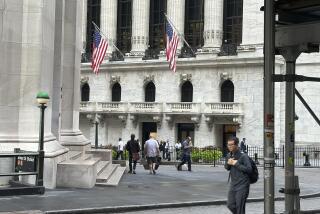NYSE shutdown rattles markets amid global fears
- Share via
NEW YORK — The New York Stock Exchange shut down for nearly four hours Wednesday as a jittery Wall Street fretted over the steep slide in Chinese markets, uncertainty in the Greek debt crisis and several electronic outages at home.
The NYSE was felled by technical problems, initially described as a software issue possibly involving an upgrade, that dealt another nick to the public’s confidence in the financial system.
Trading was abruptly halted at 11:32 a.m. EDT in the middle of a busy trading day, stunning the market and sending frazzled traders to alternative markets where stocks listed on the NYSE were still trading.
Soon afterward, the exchange issued a statement attributing the shutdown to “technical issues” and later posted a message on its Twitter account batting down any idea that the shutdown was the result of a hack.
“The issue we are experiencing is an internal technical issue and is not the result of a cyber breach,” the exchange said.
The cause of the problem “likely had to do with an upgrade, but that is premature, and it’s something that will come about as part of a full analysis of the situation,” Thomas Farley, the NYSE’s president, said in a Bloomberg TV interview. An exchange spokeswoman later said the cause had been traced to a “configuration issue.”
The rare trading shutdown of the country’s leading stock exchange rattled a market already shaken by a steep sell-off on China’s main market. The Shanghai composite index sank 5.9% on the day, part of 32% slide since the market’s peak on June 12.
At about the same time, computer glitches grounded United Airlines flights for part of the day and hit the Wall Street Journal’s website.
“If bad news comes in threes, we just got a double dose,” said Sam Stovall, U.S. equity strategist for S&P Capital IQ, who also ticked off Greece’s financial troubles and other market worries.
Major U.S. markets were down amid the hailstorm of news.
The 30-stock Dow Jones industrial average fell 261.49 points, or 1.5%, to 17,515.42. The broader Standard & Poor’s 500 index dropped 34.66, or 1.7%, to 2,046.68 and the technology-oriented Nasdaq composite tumbled 87.70, or 1.8%, to 4,909.76. European markets, which had closed by the time of the NYSE shutdown, were up slightly on the day.
Experts said the damage caused by the NYSE failure was more symbolic than substantive since trading in NYSE-listed shares continued on Nasdaq and other markets. Portfolio managers said trades went through smoothly without affecting prices.
Alan Whitman, a Morgan Stanley managing director, said he heard of the glitch through a companywide notice sent immediately after the shutdown and was able to continue to trade through an internal system that automatically shunts orders to the exchange offering the most favorable price.
“I was entering orders all morning long without interruption,” he said. “I was actually a buyer of a lot of things.”
Whitman said he fielded some calls from investors worried about their orders, but said most were reassured after learning that they could still trade and that the shutdown was not related to a cyberattack or, for that matter, to the glitch that grounded some United Airlines flights or some wider systemic problem.
The limited financial damage of the NYSE’s failure illustrated the degree to which the competitive landscape of stock exchanges has changed in recent decades and how much the Big Board’s clout has diminished.
Two decades ago, the NYSE commanded as much as 80% of the trading market, said Charles Jones, a finance professor at Columbia University’s business school.
Starting in the 1970s, however, Congress and regulators took steps to foster greater competition in the industry, culminating in a sweeping rule change in 2005, known as National Market System. The rule paved the way for a new breed of electronic markets that rapidly began to take away much of the trading volume once commanded by the Big Board.
Jones said the NYSE’s share of the daily stock trading volume, totaling about $300 billion, is now in the low teens, a fact that greatly mitigated the potential fallout from the shutdown.
“That’s a big difference,” he said. “The good news is that [the shutdown] wasn’t very disruptive.”
However, the glitch had the potential to be much more of a problem, Jones said, had the market been unable to reopen in time for a daily auction held around the NYSE’s close at 4 p.m. Eastern time, when a huge portion of the daily trading volume takes place.
The market also was lucky that no other big news took place in the day that would have sparked a surge in trading.
“In a sense, we dodged a couple of bullets,” Jones said.
The shutdown drew the attention of the White House and financial regulators. White House Press Secretary Josh Earnest said President Obama was briefed by his homeland security adviser, Lisa Monaco, and the White House chief of staff, Denis McDonough, about the shutdown.
dean.starkman@latimes.com
More to Read
Inside the business of entertainment
The Wide Shot brings you news, analysis and insights on everything from streaming wars to production — and what it all means for the future.
You may occasionally receive promotional content from the Los Angeles Times.










